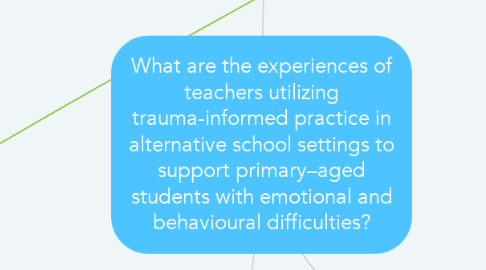
1. Emotional and Behavioural Difficulties EBD
1.1. Exclusion from mainstream schooling
1.1.1. EBD as the the special education need justifying exclusion (Jull, 2008)
1.1.2. Exploring the perspectives of high-school aged students with EBD in alternative school settings about factors contributing to their removal from mainstream education (Wise, 1998)
1.1.3. Experiences and outcomes of students with EBD (Bradley, Doolittle & Bartolotta, 2008)
1.1.4. Exploring students with EBD in Australian Schools (VanBergen, Graham, Sweller & Dodd 2015)
1.2. Outcomes and impacts of student with EBD on themselves and others
1.2.1. Negative impacts of EBD on student learning (Reid, Gonzalez, Nordness, Trout, Epstein, 2004)
1.2.2. Students with EBD disrupt classroom environments and the learning of those around them (Jull,2008)
1.2.2.1. Expert teachers create calm, inclusive and predictable classroom environments (Hattie, 2003)
2. Trauma-informed Practice
2.1. Trauma-informed practice in mainstream schools
2.1.1. The Berry Street Model was successfully implemented in two mainstream Victorian schools (Stokes and Turnbull, 2016)
2.1.2. Students in mainstream settings benefit from trauma informed practice (Brunzell, Stokes & Waters, 2016)
2.1.3. Implementation of trauma-informed practice in schools (Chafouleas, Johnson, Overstreet & Santos, 2016)
2.1.4. Using a trauma-informed whole school approach beyond behaviour management (Cavanaugh, 2016).
2.2. Trauma Informed Positive Education (TIPE)
2.2.1. Berry Street Education Model for use with mostly secondary school students at risk of disengaging from school (2015)
2.2.2. Calmer Classrooms Approach for use with primary aged traumatised children (2007)
3. Teachers supporting students with EBD
3.1. Improving teacher training
3.1.1. Exploring the qualities and skills of effective teachers of students with EBD (Leggio & Terras, 2019)
3.1.2. Towards a partnership model of teacher training in EBD (Blake & Monahan, 2007)
3.1.3. Training mainstream classroom teachers on using behaviour-specific praise with EBD students (Allan, Hinkson-Lee, Hudson, Neilson-Gatti, Kleinkw & Russell, 2012)
3.2. Experiences of teachers
3.2.1. Decrease in teacher efficacy when teaching students with EBD (O'Leary, 2018)
3.2.2. Disruptive students with persistent, overt misbehaviour are general education teachers' greatest professional frustration (Lachelt, 2016)
3.2.3. Exploring the perspectives of alternative school teachers of students with EBD on why they left (Bell, 2012)

